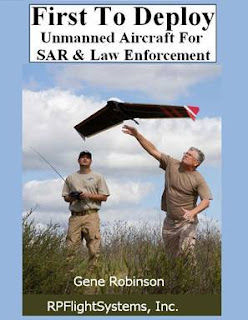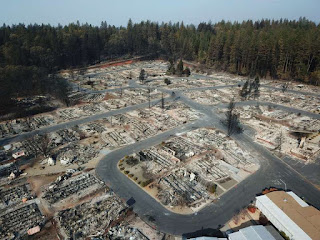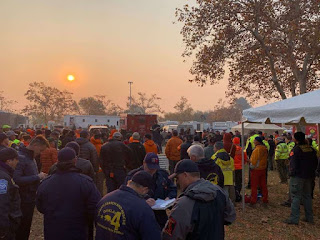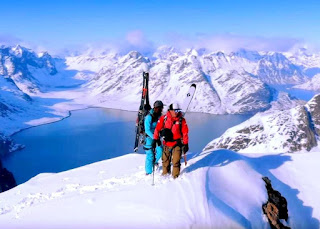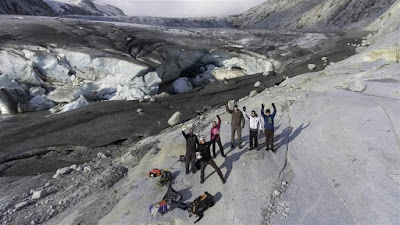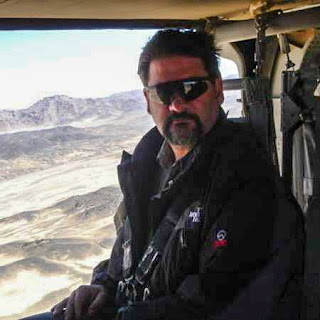Thursday, December 27, 2018
Does your UAS Program Display a Level of Commitment
Monday, December 3, 2018
Mapping Camp Fire Disaster with Drones
Thursday, November 29, 2018
DroneSAR & the Irish Coast Guard
Learn about how the Irish Coast Guard use drones to reduce risk and save lives
Do you have a story of drones coming to the rescue or assisting your agency? Please share in the comments.
Friday, November 9, 2018
Expedition Greenland: Jimmy Chin Takes the DJI Mavic Zoom for a Spin
“Incredible” – A Drone That Films While its Carried in the Top of (Your) Pack
Monday, November 5, 2018
Will These Rescue Drones Replace Lifeguards?
Larry Richardson November 3, 2018
Innovative life-saving drone tech could be coming to a beach near you. Delray Beach Ocean Rescue in Florida is the first lifeguard team in the United States to watch a demonstration of new drone technology designed to assist lifeguards in a rescue. In January 2018, the Westpac Little Ripper Lifesaver drone helped save two teenage boys caught in wild surf off Lennox Beach in Australia. Now, the company that makes the rescue drones is bringing the lifesaving technology to the US.
Friday, October 26, 2018
Drone Search and Rescue Study Reveals Potential Limits
A new study on the effectiveness of drones in finding lost individuals demonstrates drones can be an excellent tool, but a drone alone is no guarantee of a successful outcome.
The study on the effectiveness of drones in search-and-rescue (SAR) operations involved a series of simulated scenarios in Ireland and Wales, with drone-equipped teams searching for simulated victims alongside ground-only teams. They found that while drones could find victims about three minutes faster, the overall success rates were similar. The study, conducted by DJI, the European Emergency Number Association, and Black Channel, was presented at a recent conference and posted online.
Do you have a story of drones coming to the rescue or assisting your agency? Please share in the comments.
Thursday, August 30, 2018
EMMU Aerial’s Managing Director Dave Crago Flies Above the Crowd
Today, Dave is an FAA licensed Part 107 UAS and federal government remote pilot and brings extensive knowledge of FAA and other federal, state and local drone regulations and protocols to the company. Dave developed his skills through extensive operational aerial photography, remote sensing and UAS surveillance work with the military and government agencies. From these beginnings with government systems, EMMU Aerial now provides public safety agencies and organization with specialized UAS training, services and consulting for search and rescue, law enforcement, firefighting, disaster response and more throughout North America. EMMU Aerial is at the forefront of a technological and operational change, focused on reinventing the way we work and look at the world.
Thursday, August 16, 2018
Wrightsville Beach Testing Drones In Water Rescues
The department is testing equipment that allows drones to
carry a lightweight inflatable buoy to swimmers who might be in distress,
according to Wrightsville Beach firefighter Sam Proffitt. He said the drone can
quickly fly a few hundred yards and drop the device.
"It will inflate once it hits the water. They can grab
it and they can either hold it or clip it to them, and then we still have the
other end of the rope on the beach. We take that, wrap it around the hitch on
the back of a truck, and slowly pull that person into shore," Proffitt
said.
The system is meant to assist lifeguards, not replace them,
according to Proffitt. But drones could help law enforcement agencies in towns
and cities where there are no lifeguards on duty.
"If someone gets in distress in a rip current, a lot of
times it falls on a fire department to figure out how they're going to rescue
that person," he said. "And you read a lot of stories where the
rescuer then a lot of times becomes a victim because they're not trained to
perform the rescue, so this could be a great option for them."
Even without the buoys, drones provide an extra set of eyes,
Proffitt said. Local law enforcement agencies across the state have been
experimenting with drones to help find victims of natural disasters, traffic
accidents and other emergencies.
A Wrightsville Beach drone happened to be in the air Tuesday
when the pilot spotted a swimmer in trouble and alerted rescuers. Watch them
respond:
The swimmer was safely pulled from the water. Rescuers have saved hundreds of people along the coast this summer who were caught in suspected rip currents, but at least three have died.
Proffitt said the drone system is promising, but not
perfect. There are tight restrictions on air space and drone regulations that
prohibit pilots from flying them outside their line of sight.
Saturday, August 11, 2018
Will drones change the face of mountaineering and freeriding forever?
Wednesday, June 20, 2018
Drone finds 75-year-old man who got stuck in marshes
A 75-year-old man who got lost while out walking with friends was found by a drone 20 hours after he was reported missing. Peter Pugh had been walking with friends and family on Brancaster Beach at approximately 5pm on June 16 when he became separated from the group. Footage from the drone shows how Mr Pugh was found at approximately 2:30pm the following day after becoming stuck in the marshes.
Do you have a story of drones coming to the rescue or assisting your agency? Please share in the comments.
Thursday, June 14, 2018
Rescue drones begin operations in Baltic Sea
For the first time, drones equipped with Restube-buoys
will be used on the Baltic Sea coast in Germany to give help to swimmers in
distress
For the first time, drones equipped with Restube-buoys will
be used on the Baltic Sea coast in Germany to give help to swimmers in
distress. Start-Up company RESTUBE GMBH equipped the lifeguards of the German
Red Cross division with its safety device for drones for all 14 beaches at the
Baltic Sea.
Water Rescue in Mecklenburg-Western Pomerania started
officially at the beginning of the 2018 swimming season. Restubes do not
replace lifeguards but the time until the person in water receives flotation
assistance can be reduced radically with its deployment. Once the Restube-buoy
is dropped, it inflates automatically with water contact so that the rescued
person can hold on until a lifeguard arrives.
The lifeguards of the German Red Cross Division operate 18
Restube equipped drones at 14 beach sections at the Baltic Sea as well as on
four inland lakes.
Friday, June 1, 2018
Training - Part 107 Drone Pilot Test Prep Course
- Applicable regulations relating to small unmanned aircraft system rating privileges, limitations, and flight operation
- Airspace classification and operating requirements, and flight restrictions affecting small unmanned aircraft operation
- Aviation weather sources and effects of weather on small unmanned aircraft performance
- Small unmanned aircraft loading and performance
- Emergency procedures
- Crew resource management
- Radio communication procedures
- Determining the performance of small unmanned aircraft
- Physiological effects of drugs and alcohol
- Aeronautical decision-making and judgment
- Airport operations
- Maintenance and preflight inspection procedures
- 16 Hours of In-Person Training
- Learn from one of our expert instructors
- Part 107 Student Guide
- Practice Test Questions
- Money Back Guarantee*
Thursday, May 31, 2018
Drone Used to Help Rescue 4 Stranded in Brazos
A drone, flown by Hill County Emergency Management Coordinator Tom Hemrick, delivered a lifejacket to a mother and her 15-year-old daughter to keep them afloat before a rescue boat arrived.
Tuesday, May 29, 2018
Colorado search and rescue teams are using drones to find lost adventurers
To more efficiently manage already limited resources, volunteer search and rescue teams across the state are now using drones as their eyes in the sky.
Friday, April 20, 2018
Police use of drones expands rapidly in North Carolina
A small unmanned aircraft system, or drone, being
operated by the Fayetteville Police Department. Courtesy of the city of
Fayetteville
On a cold Christmas Eve night, the man found himself stuck
up to his waist in the mud of a swampy area surrounded by deep and frigid
creeks in Cumberland County, when a small flying object passed over his head.
The object was a Fayetteville Police drone. It may have
saved his life.
The man “had outstanding warrants and ran from a traffic
stop … to elude officers,” Fayetteville Police Chief Gina V. Hawkins told
Carolina Public Press.
“The subject crossed at least two sections of creek that
were over his head. The temperature that night was 40 degrees and the suspect
became lodged in the mire. The incident quickly became a rescue mission with
the use of the drone to safely guide the officers to the suspect’s location.”
Fayetteville police publicly unveiled their year-old drone
program on April 10, touting its early successes, including the Dec. 2017
rescue as one of their small unmanned aircraft systems (sUAS) program’s
successes.
“Due to the frigid temperatures at the time and … that the
suspect was stuck in silt, it is highly probable the suspect would have
succumbed to hypothermia without the aid of the aviation unit,” a Fayetteville
Police Department statement said.
A growing number of law enforcement agencies in North
Carolina have initiated drone programs since 2016, when recent changes in both
costs and regulations made the unmanned systems practical for local agencies.
The promise of drones, like any tool, comes with concerns
about their potential abuse. Observers wonder about erosion of protections
against unlawful searches. Courts and lawmakers haven’t yet set precedents or
passed legislation to address all of the potential questions raised by the
rapidly developing technology.
Law enforcement agencies are keenly aware of these concerns.
But as CPP talked with agencies across the state, their answers to drone use
varied widely.
While Fayetteville emphasized the potential for drones in
rescue situations and said the department will not use them for “vehicle
pursuits, to assist in issuing traffic citations (or) for routine patrols,” the
December incident was also described as an effort to located a wanted suspect.
This article takes a look at the rapid adoption of drones by
the law enforcement and the legal and practical implications.
Read More; Carolina Public Press
Friday, February 2, 2018
New Search and Rescue Drone - Texas Parks and Wildlife Department
Texas game wardens are adding a new set of eyes in the sky with a new Search and Rescue Drone or Unmanned Aircraft System (UAS). Watch this simulated rescue of some lost children.
Friday, January 26, 2018
Training - Small Unmanned Aircraft System (sUAS) Basic Remote Pilot Course for Public Safety
Course Description:
UAS can positively impact every element of your agencies by utilizing state of the art equipment. UAS derived data and imagery empowers firefighter, law enforcement, incident personnel, and senior leaders to make informed decisions based on precise and real-time information. Data gathered from UAS is unique due to the ability of the aircraft to fly low, slow, and for long periods of time while collecting high-resolution imagery.
The Basic Remote Pilot Course is designed to qualify students to safely operate a sUAS in the field environment and capture video/stills of a point of interest with multirotor aircraft and applicable sensors.
Friday, January 19, 2018
Drone Rescues Swimmers Caught in Rough Surf in Australia in World First
Caught in rough surf far from shore, stranded swimmers might hope for a lifeguard to appear amid the waves.
-
While looking back at some recent search and rescue operations that utilized drones, I came across a rescue on January 20 th and an earlier...
-
Over the years, EMMU Aerial has helped countless drone pilots in passing their aeronautical knowledge test to get an FAA Part 107 Remote Pil...
-
Aloft Technologies, Inc. (Aloft), a leader in advanced drone software solutions, is thrilled to announce the integration of Automated Spec...

